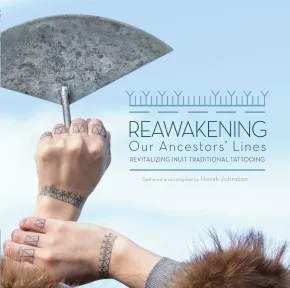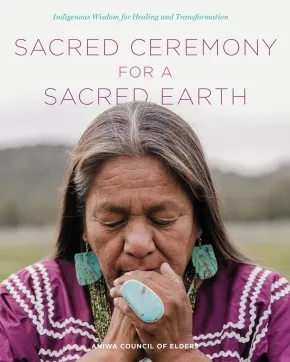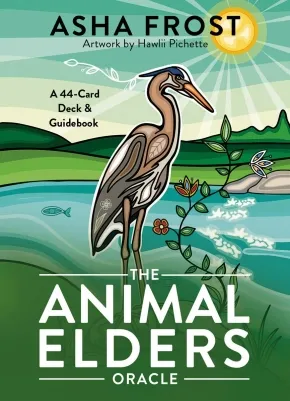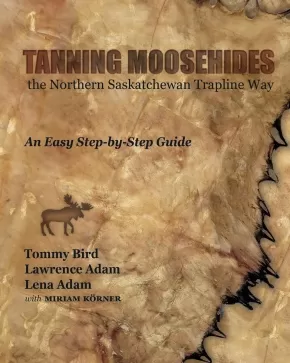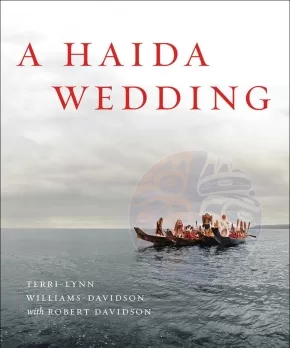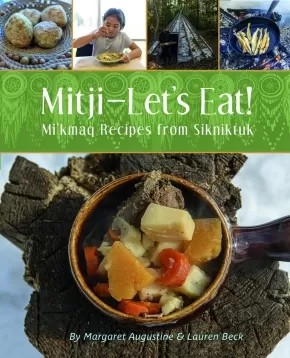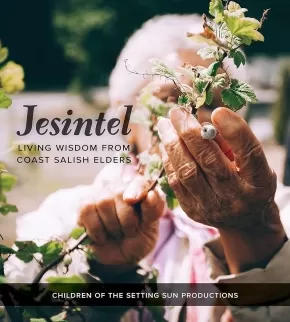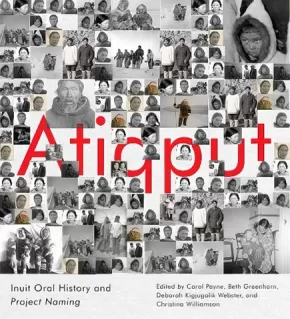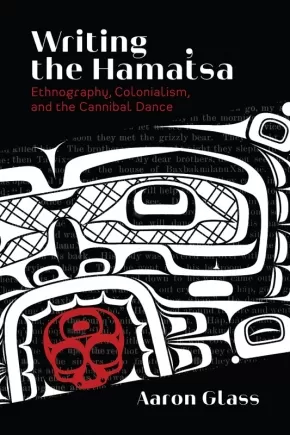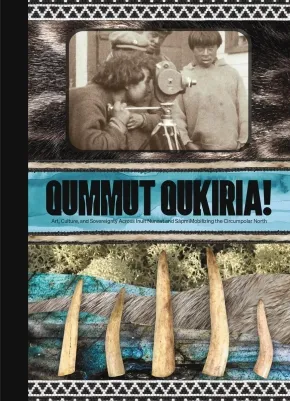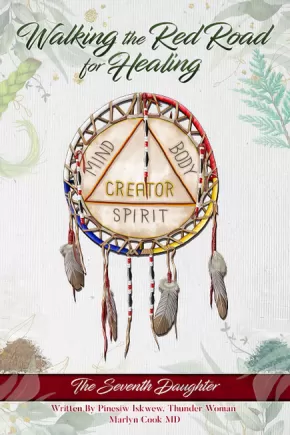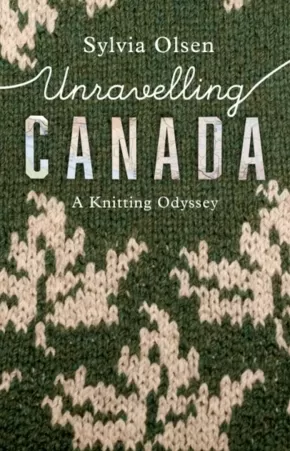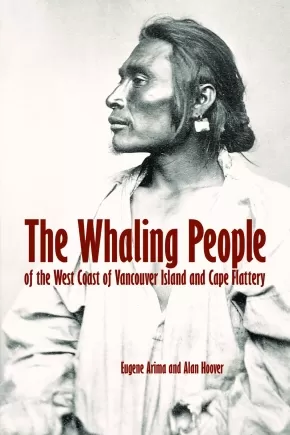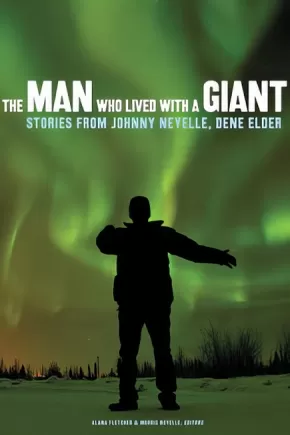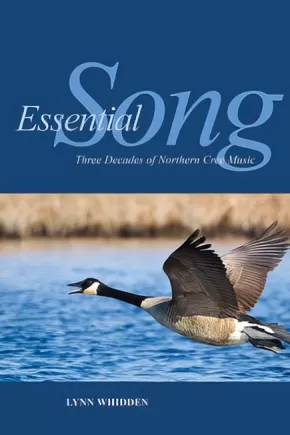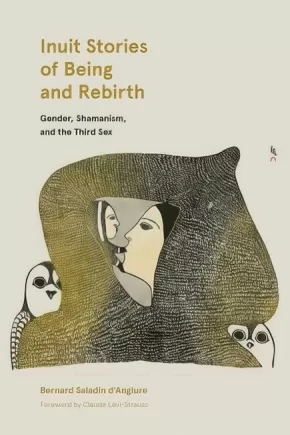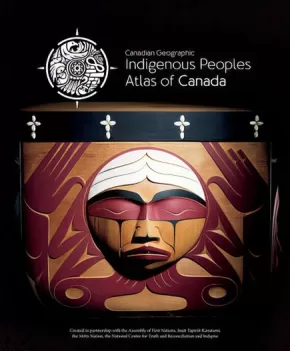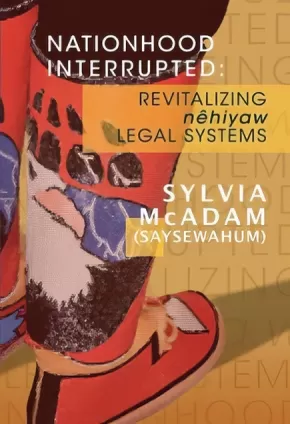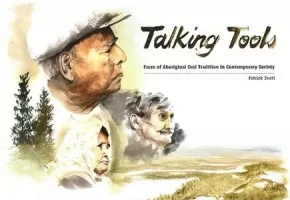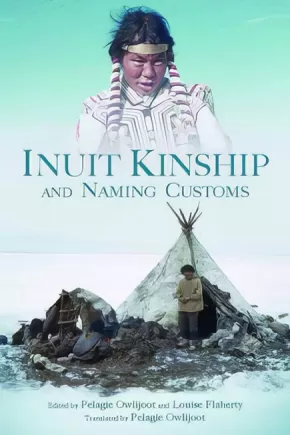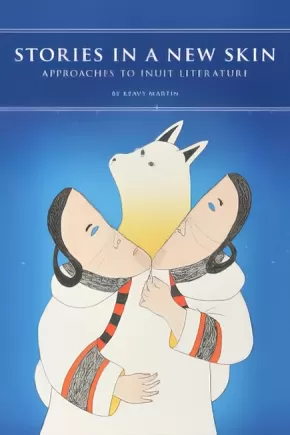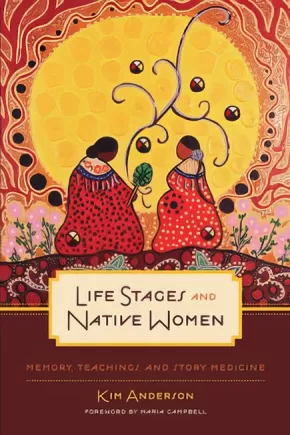
Customs and Traditions
1
-
15
of
29 Results;
Sort By
Go To
of 2
Reawakening Our Ancestors' Lines: Revitalizing Inuit Traditional Tattooing (PB)
$24.95
Format:
Paperback
Text Content Territories:
Indigenous Canadian; Inuit;
Reading Level: N/A
ISBN / Barcode: 9781772275698
Synopsis:
Synopsis:
For thousands of years, Inuit practiced the traditional art of tattooing. Created the ancient way, with bone needles and caribou sinew soaked in seal oil, sod, or soot, these tattoos were an important tradition for many Inuit women, symbols etched on their skin that connected them to their families and communities. But with the rise of missionaries and residential schools in the North, the tradition of tattooing was almost lost. In 2005, when Angela Hovak Johnston heard that the last Inuk woman tattooed in the old way had died, she set out to tattoo herself in tribute to this ancient custom and learn how to tattoo others. What was at first a personal quest became a project to bring the art of traditional tattooing back to Inuit women across Nunavut, starting with Johnston’s home community of Kugluktuk. Collected in this beautiful book are moving photos and stories from more than two dozen women who participated in Johnston’s project. Together, these women have united to bring to life an ancient tradition, reawakening their ancestors’ lines and sharing this knowledge with future generations.
Awards
- 2018 NorthWords Book Prize Winner
Reviews
"This gorgeous photographic essay on the Inuit Tattoo Revitalization Project is a deeply personal and affirming work about learning and preserving traditions-and reclaiming what residential schools tried to destroy."-School Library Journal
Additional Information
72 pages | 10.00" x 10.00" | Paperback
Sacred Ceremony for a Sacred Earth: Indigenous Wisdom for Healing and Transformation
$52.99
Format:
Hardcover
Text Content Territories:
Indigenous;
Reading Level: N/A
ISBN / Barcode: 9780760392126
Synopsis:
Synopsis:
For the first time, over a dozen respected Indigenous elders from around the world have united to share their timeless wisdom beyond their lands and lineages.
Aniwa’s Council of Elders includes some of the globe’s most renowned Indigenous Wisdom Keepers. In a time fraught with ecological, social, political, and mental health crises, they share a mission to unite people of all races, colors, and creeds to promote healing and a deeper reciprocal relationship with our planet. Sacred Ceremony for a Sacred Earth brings together their profound teachings, stories, sacred ceremonies, and healing practices, amplifying the voices of Indigenous healers from diverse traditions.
In their worldview, we are all children of Mother Earth, destined to return to her embrace. This extraordinary book serves as a guiding light, beckoning humanity back to ancestral wisdom and restoring forgotten bonds with nature and self through ceremonies and practices.
Embark on a journey of self-discovery, unveiling the purpose of your soul and reclaiming your intrinsic relationship with Mother Earth, through ancient practices such as:
- Use of Feathers to Bless Yourself and Relieve Pain
- Pagamento for Trees
- Hopi Message of Comfort to Say Good-Bye to Loved Ones Who Have Passed
- Practices for Conscious Conception
- Create a Spiritual House for Your Inner Child
- The Feagaiga (Sacred Promise or Covenant) with Mother Earth
- Connect with Your Ancestors
Sacred Ceremony for a Sacred Earth calls upon us to awaken and rekindle the flame of connection with our roots and the natural world. Let the eternal wisdom of elders guide you toward healing, growth, and a profound reconnection with nature.
Reviews
"An essential guide to begin understanding culture, nature, and yourself."—Oona Chaplin, actress
"Beautifully and profusely illustrated throughout with full color photography of indigenous people, rituals, events, Sacred Ceremony for a Sacred Earth is informative, fascinating, insightful, and unreservedly recommended."—Midwest Book Review
Educator Information
Discover rituals and wisdom from Indigenous communities across the globe that, until now, have only been passed down orally and taught within closed circles.
Additional Information
224 pages | 8.30" x 10.25" | Hardcover
The Animal Elders Oracle: A 44-Card Deck & Guidebook of Indigenous Wisdom & Healing Medicine
$25.99
Artists:
Text Content Territories:
Indigenous Canadian; First Nations; Anishinaabeg; Ojibway;
Reading Level: N/A
ISBN / Barcode: 9781401978181
Synopsis:
Synopsis:
Tap into guidance from the animal spirit realm and connect to ancestral wisdom with this transformative 44-card deck and guidebook from Indigenous Medicine Woman and author of You Are the Medicine and The Sacred Medicine Oracle, Asha Frost.
Everything is interconnected. All of creation carries a spirit. Indigenous people have always had a sacred relationship with animals and treated them as honored elders. Animal beings in the spirit realm are part of our spiritual support team as allies and medicine keepers, ready to help, waiting to remind you of your humanity and deep connection to the natural world.
With 44 Elder Animals depicted in a richly detailed traditional Ojibway art style, each card carries its own unique medicine. This deck offers meaningful insights and messages to guide you on your path both from the universe and in the voice of an animal spirit guide from the lands of the Ojibway people—from Elder Artic Hare to Elder Wolf. Whether you're seeking clarity, healing, or a deeper connection to your ancestral lineage, these cards provide a bridge to the spirit world.
Use this deck your rituals and ceremonies, do readings with it for your clients and friends, and share it with your communities. As the medicine ripples out, hold Indigenous people in your heart and honor how their history continues to impact your current reality.
Additional Information
128 pages | 3.50" x 5.00" | Card Deck & Guidebook
Tanning Moosehides: The Northern Saskatchewan Trapline Way
$49.95
Format:
Coil Bound
Text Content Territories:
Indigenous Canadian; First Nations; Dene; Denesuline (Chipewyan); Fond du Lac Denes??iné First Nation; Cree (Nehiyawak); Woodland Cree; Rocky Cree; Peter Ballantyne Cree Nation;
ISBN / Barcode: 97817786903
Synopsis:
Synopsis:
Denesųłiné Elders Lawrence and Lena Adam have been tanning hides and sharing their knowledge with others for more than four decades. Woodland Cree knowledge carrier Tommy Bird helped his family tan hides on the trapline as a young boy. Together they share their lifetime of experience to guide a new generation of hide tanners to keep the tradition alive. The trouble-shooting tips and hands-on advice in this book will help you to make your own bone tools and turn raw moosehides into smoke-tanned hides soft enough to sew into mitts or moccasins. Combining traditional knowledge with easy-to-follow instructions and detailed colour photos, Tanning Moosehides the Northern Saskatchewan Trapline Way is a practical guide you will refer to again and again.
Educator Information
The publisher recommends this resource for ages 10+
Recommended in the Indigenous Books for Schools catalogue as a valuable resource for Art, Science, and Social Studies in grades 5 to 12.
Themes: Animals, Arts and Culture, Cultural Teachings, Fashion, Traditional Knowledge.
Additional Information
64 pages | 8.50" x 11.00" | Spiral Bound
A Haida Wedding
$29.95
Format:
Hardcover
Reading Level: N/A
ISBN / Barcode: 9781772034516
Synopsis:
Synopsis:
A visual and cultural celebration of a traditional Haida wedding ceremony, exploring its roots, rituals, symbolism, joyfulness, and contemporary significance for a thriving Indigenous Nation.
In 1996, Terri-Lynn Williams and Robert Davidson celebrated their wedding with a traditional ceremony, the first in over a century that was legalized under Haida law. This book provides an intimate photographic window into that momentous day and marks the resurgence of a tradition that was nearly lost to colonial forces.
Relying on recorded knowledge their ancestors had shared with ethnographers and anthropologists, and the few details living Elders could recall about the tradition of guud ‘iina Gihl (“becoming married”) in the time before the arrival of Christian missionaries, the couple carefully planned out a seven-part celebration. It involved a canoe procession, ceremony, feast, dancing, and dowry payment, signifying the coming together of two people, two families, and two clans. The occasion is lovingly and painstakingly recounted through imagery and text in this fascinating tribute to a resilient culture and the unbreakable bonds of love and family.
Additional Information
128 pages | 8.75" x 10.50"| Hardcover
Mitji- Let's Eat!: Mi'kmaq Recipes from Sikniktuk
$29.95
Artists:
Format:
Paperback
Text Content Territories:
Indigenous Canadian; First Nations; Mi'kmaq;
Reading Level: N/A
ISBN / Barcode: 9781774712276
Synopsis:
Synopsis:
An intergenerational source of wisdom and knowledge, Mitji combines a cultural history of Mi'kmaw cuisine with a practical cookbook.
The welcome call of "Mitji" can be heard by Mi'kmaw children, hungry workers, family, and friends when dinner is ready. This book, too, is an invitation to celebrate and practice Mi'kmaq foodways: the recipes passed down from one generation to the next; the way traditional foods and medicines are gathered, hunted, and cooked; and the lived experience of ancestors and Elders about how to nourish the spirit and body through Mi'kmaw culture and knowledge.
Mitji – Let's Eat! Mi'kmaq Recipes from Sikniktuk offers over 30 traditional and popular Mi'kmaq recipes, arranged seasonally — like Fish Cakes and Eel Stew in spring; Blueberry "Poor Man's Cake" and Stuffed Salmon in summer; Swiss Steak with Moose Meat and Apple Pie in fall; and Molasses Cake and Wiusey Petaqn in winter.
Each recipe is contextualized with its origins, contributor information, food stories, and detailed preparation instructions, and throughout the book are short essays on Mi'kmaw cuisine, drawing a picture of how Mi'kmaq foodways were influenced by colonization, on the one hand, and how food became and remains a significant vehicle of resistance, on the other. Whether a novice or well-seasoned cook, Mitji is a feast for the reader: a bountiful introduction to, and celebration of, Mi'kmaw cuisine.
Educator Information
Subjects & Curriculum Links: Indigenous Cooking, Seasons, Indigenous History, Mi'kmaw Culture and Cuisine
This book has received the Authentic Indigenous Text label because of the Indigenous contributions to this work. It is up to readers to determine if it's an authentic resource for their purposes.
Additional Information
240 pages | 7.50" x 9.25" | Photos by Patricia Bourque, 50+ Coloured Images
The Sacred Medicine Oracle: A 56-Card Deck and Guidebook
$35.99
Artists:
Text Content Territories:
Indigenous Canadian; First Nations; Anishinaabeg;
Reading Level: N/A
ISBN / Barcode: 9781401966782
Synopsis:
Synopsis:
Connect with healing traditions, stories, ancestral wisdom, and animal guidance through this 56-card deck and guidebook from Indigenous Medicine Woman and author of You Are the Medicine, Asha Frost.
Indigenous people know the power of earth and spirit medicine. Everything in our natural world is interconnected and sacred. The plants, animals, rocks, waters, stars, moon are our relations, our kin. Every aspect of creation has a spirit. This spirit lives in all things and informs us how to walk in a good way or, in Anishinaabemowin, Mino-bimaadiziwin.
The Sacred Medicine Oracle was birthed to invite readers into a conscious and respectful relationship with medicine teachings, awakening a daily connection to your own inner divinity, power, and wisdom. From the powerful remembering of "Past Life Medicine" to the promise of miracles with "Jingle Dress," each of the 56 cards depicts ceremony, traditions, moon phases, animal guides, and plant allies, all of them alive with energy and blessed with healing intentions from the ancestors.
Additional Information
144 pages | 4.88" x 5.38" | 56 Cards and Guidebook
Jesintel: Living Wisdom from Coast Salish Elders
$48.00
Artists:
Format:
Paperback
Text Content Territories:
Indigenous Canadian; First Nations; Salish; Coast Salish; Sto:lo; Saanich (WSANEC); Tsartlip; Musqueam; Malahat; Cowichan; Tsleil-Waututh; Indigenous American; Native American; Salish; Coast Salish; Tulalip; Swinomish; Snoqualmie; Nisqually; Muckleshoot; Lhaq'temish (Lummi Nation); Klallam (Clallam); Jamestown S'Klallam;
Grade Levels: 12; University/College;
ISBN / Barcode: 9780295748641
Synopsis:
Synopsis:
“We need to learn and grow together, and if we are able to do this, we will create harmony,” counsels Tom Sampson, an elder of Tsartlip First Nation in British Columbia.
Dynamic and diverse, Coast Salish culture is bound together by shared values and relations that generate a resilient worldview. Jesintel—"to learn and grow together"—characterizes the spirit of this book, which brings the cultural teachings of nineteen elders to new generations.
Featuring interviews that share powerful experiences and stories, Jesintel illuminates the importance of ethical reciprocal relationships and the interconnectedness of places, land, water, and the spirit within all things. Elders offer their perspectives on language revitalization, Coast Salish family values and naming practices, salmon, sovereignty, canoe racing, and storytelling. They also share traumatic memories, including of their boarding school experiences and the epidemics that ravished their communities. Jesintel highlights the importance of maintaining relations and traditions in the face of ongoing struggles. Collaboration is at the heart of this work and informs how the editors and community came together to honor the boundless relations of Coast Salish people and their territories.
Elders Interviewed:
Tom Sampson (Tsartlip First Nation)
Virginia Cross (Muckleshoot Tribe)
Ernestine Gensaw (Lummi Nation)
Steve and Gwen Point (Stó:lō Nation)
Gene and Wendy Harry (Malahat Nation)
Claude Wilbur (Swinomish Tribe)
Richard Solomon (Lummi Nation)
Elaine Grinell (Jamestown S’Klallam Tribe)
Arvid Charlie (Cowichan Nation)
Amy George (Tsleil-Waututh Nation)
Nancy Shippentower (Nisqually Tribe)
Nolan Charles (Musqueam Indian Band)
Andy de los Angeles (Snoqualmie Tribe)
Jewell James (Lummi Nation)
Kenny Moses Sr. Family (Tulalip Tribal Nation)
Ramona Morris (Lummi Nation)
Reviews
"A beautiful sharing of thriving Coast Salish communities. Indigenous elders, cultures, and languages have so much precious wisdom to share, and Jesintel celebrates these through storytelling and photos. It is a generous gift to anyone who wants to better understand the resilience of Indigenous communities."- Michelle M. Jacob (Yakama), author of The Auntie Way: Stories Celebrating Kindness, Fierceness, and Creativity
Educator Information
Nineteen elders from Coast Salish communities in the Pacific Northwest and British Columbia offer a portrait of their perspectives on language, revitalization, and Coast Salish family values. Topics include naming practices, salmon, canoe journeys and storytelling.
Additional Information
224 pages | 9.00" x 10.00" | 144 colour illustrations | 1 map | Paperback
Atiqput: Inuit Oral History and Project Naming
$45.95
Editors:
Format:
Hardcover
Text Content Territories:
Indigenous Canadian; Inuit;
Reading Level: N/A
ISBN / Barcode: 9780228011057
Synopsis:
Synopsis:
A multigenerational discussion of culture, history, and naming centring on archival photographs of Inuit whose names were previously unrecorded.
"Our names - Atiqput - are very meaningful. They are our identification. They are our Spirits. We are named after what's in the sky for strength, what’s in the water ... the land, body parts. Every name is attached to every part of our body and mind. Yes, every name is alive. Every name has a meaning. Much of our names have been misspelled and many of them have lost their meanings forever. Our Project Naming has been about identifying Inuit, who became nameless over the years, just "unidentified eskimos ..." With Project Naming, we have put Inuit meanings back in the pictures, back to life." Piita Irniq
For over two decades, Inuit collaborators living across Inuit Nunangat and in the South have returned names to hundreds of previously anonymous Inuit seen in historical photographs held by Library and Archives Canada as part of Project Naming. This innovative photo-based history research initiative was established by the Inuit school Nunavut Sivuniksavut and the national archive.
Atiqput celebrates Inuit naming practices and through them honours Inuit culture, history, and storytelling. Narratives by Inuit elders, including Sally Kate Webster, Piita Irniq, Manitok Thompson, Ann Meekitjuk Hanson, and David Serkoak, form the heart of the book, as they reflect on naming traditions and the intergenerational conversations spurred by the photographic archive. Other contributions present scholarly insights and research projects that extend Project Naming’s methodology, interspersed with pictorial essays by the artist Barry Pottle and the filmmaker Asinnajaq.
Through oral testimony and photography, Atiqput rewrites the historical record created by settler societies and challenges a legacy of colonial visualization.
Reviews
“Atiqput brings together statements by Inuit artists, elders, and activists with work by project facilitators and scholars to produce a vibrant tapestry that at once mourns the losses of the past, treasures the traces that can be regained, and celebrates the continued power of Inuit cultural forms.” - Peter Kulchyski, University of Manitoba and author of Report of an Inquiry into an Injustice: Begade Shutagot’ine and the Sahtu Treaty
Additional Information
264 pages | 9.00" x 10.00" | Hardcover
Making a Chaputs: The Teachings and Responsibilities of a Canoe Maker
$24.95
Format:
Paperback
Text Content Territories:
Indigenous Canadian; First Nations; Nuu-chah-nulth (Nootka); Tla-o-qui-aht First Nation;
Reading Level: N/A
ISBN / Barcode: 9780772680273
Synopsis:
Synopsis:
A rich visual testament to the practical and cultural power of the dugout canoe, balanced in its description of meaning and method.
Tla-o-qui-aht master canoe maker Joe Martin, in collaboration with former museum curator Alan Hoover, describes the meaning and method behind one of the most vivid and memorable symbols of the Northwest Coast: the dugout canoe. Both artform and technological marvel, the chaputs carries Indigenous cultural knowledge passed down through generations, not only of the practical forestry and woodworking that shape every canoe, but also of the role and responsibilities of the canoe maker.
The text includes both a step-by-step explanation of the canoe-making process from tree selection onward (carefully described and dynamically illustrated) and the personal histories of a number of Joe's canoes, encompassing their planning, creation, cultural significance and role in the process of reconciliation. The teachings Joe received from his father and the expertise he has gained in a lifetime of canoe-making are recorded here in his own words for generations to come.
Reviews
“In Making a Chaputs, Nuu-chah-nulth canoe artist Joe Martin shows how he carves dugout canoes, explaining how and why he makes two full-size canoes from a single cedar log. It is a clever, amazing tradition rooted in deep respect for the forest and a lifetime of Indigenous knowledge—a highly recommended book!”—Kathryn Bernick, archaeologist and author of numerous books including Waterlogged: Examples and Procedures for Northwest Coast Archaeologists and Basketry and Cordage from Hesquiat Harbour
“When tracing ancient basketry styles in the archaeological waterlogged/wet sites of the Salish Sea for thousands of years, we defined our approach as Generationally-Linked Archaeology. As seen at the Makah Ozette Village archaeological wet site from ca. 1700, preserved chaputs canoe models reflect this West Coast tradition a full 16 generations back. Joe Martin, Tla-o-qui-aht First Nation Elder and master canoe carver, best reflects these generationally linked traditions, constructing over 60 full-size chaputs, passing this paramount art on through Native apprentices and, here, in his own words, with esteemed curator and author Alan Hoover.” —Ed Carriere, Suquamish Elder and Master Basketmaker and Coast Salish Canoe Carver, and Dale R. Croes, Ph.D. Northwest Coast wet site archaeologist, Washington State University, co-authors of Re-Awakening Ancient Salish Sea Basketry
Additional Information
96 pages | 8.97" x 8.97" | Paperback
Writing the Hamat'sa: Ethnography, Colonialism, and the Cannibal Dance
$34.95
Format:
Paperback
Text Content Territories:
Indigenous Canadian; First Nations; Kwakwaka'wakw (Kwakiutl); Namgis; Salish; Coast Salish; K'omoks;
Reading Level: N/A
ISBN / Barcode: 9780774863780
Synopsis:
Synopsis:
Long known as the Cannibal Dance, the Hamat̓sa is among the most important hereditary prerogatives of the Kwakwa̱ka̱ꞌwakw of British Columbia. Writing the Hamat̓sa offers a critical survey of attempts to record, describe, and interpret the dance under shifting colonial policy. In the late nineteenth century, as anthropologists arrived to document the practice, colonial agents were pursuing its eradication and Kwakwa̱ka̱ꞌwakw were adapting it to ensure its survival. In the process, the dance – with dramatic choreography, magnificent bird masks, and an aura of cannibalism – entered a vast and variegated library of ethnographic texts.
Drawing on close, contextualized reading of published texts, extensive archival research, and fieldwork, Aaron Glass analyses key examples of overlapping genres over four centuries: the exploration journal, the territorial survey, the missionary polemic, settler journalism, government reports, anthropological works (especially by Franz Boas and George Hunt), poetry, fiction, and Indigenous (auto)biography.
Going beyond postcolonial critiques of representation that often ignore Indigenous agency in the ethnographic encounter, Writing the Hamat̓sa focuses on forms of textual mediation and Indigenous response that helped transform the ceremony from a set of specific performances into a generalized cultural icon. This meticulous work illuminates how Indigenous people contribute to, contest, and repurpose texts in the process of fashioning modern identities under settler colonialism.
This comprehensive critical survey of ethnographic literature on the Hamat̓sa ceremony will be an invaluable resource for scholars and students of the Northwest Coast in a range of disciplines – Indigenous studies, anthropology and history of anthropology, ethnohistory, BC studies, art history, museum studies, and material culture – as well as for Kwakwa̱ka̱ꞌwakw/Indigenous readers.
Educator Information
Table of Contents
Foreword / Chief William Cranmer/T̓łlakwagila (ꞌNa̱mg̱is Nation)
Prologue: Points of Arrival and Departure
Introduction: From Writing Culture to the Intercultural History of Ethnography
1 A Complex Cannibal: Colonialism, Modernity and the Hamat̓sa
2 Discursive Cannibals:The Textual Dynamics of Settler Colonialism, 1786–1893
3 The Foundations of All Future Researches: The Work of Franz Boas and George Hunt, 1886–1966
4 Reading, Rewriting, and Writing Against: Changing Anthropological Theory, 1896–1997
5 From Index to Icon: (Auto)Biography and Popular Culture, 1941–2012
6 Reading Culture, Consuming Ethnography
Afterword: Between This World and That / Andy Everson/Tanis (K̕ómoks Nation)
Appendices
Glossary
Notes; References; Index
Additional Information
512 pages | 6.00" x 9.00" | 28 b&w photos, 2 maps | Paperback
Qummut Qukiria!: Art, Culture, and Sovereignty Across Inuit Nunaat and Sapmi: Mobilizing the Circumpolar North
$45.00
Editors:
Format:
Hardcover
Text Content Territories:
Indigenous Canadian; Inuit; Indigenous European; Greenlandic Inuit; Sami;
ISBN / Barcode: 9781773102245
Synopsis:
Synopsis:
Qummut Qukiria! celebrates art and culture within and beyond traditional Inuit and Sámi homelands in the Circumpolar Arctic — from the continuance of longstanding practices such as storytelling and skin sewing to the development of innovative new art forms such as throatboxing (a hybrid of traditional Inuit throat singing and beatboxing). In this illuminating book, curators, scholars, artists, and activists from Inuit Nunangat, Kalaallit Nunaat, Sápmi, Canada, and Scandinavia address topics as diverse as Sámi rematriation and the revival of the ládjogahpir (a Sámi woman’s headgear), the experience of bringing Inuit stone carving to a workshop for inner-city youth, and the decolonizing potential of Traditional Knowledge and its role in contemporary design and beyond.
Qummut Qukiria! showcases the thriving art and culture of the Indigenous Circumpolar peoples in the present and demonstrates its importance for the revitalization of language, social wellbeing, and cultural identity.
Educator Information
Qummut Qukiria! means "up like a bullet" in Inuktitut and is used to convey excitement and enthusiasm. It also signifies the connection to the land and nature's offerings in the Circumpolar North.
Features over 200 images as well as essays from artists, educators, and scholars on contemporary Inuit and Sámi life and art, including filmmaking, sculpture, storytelling, and design.
Additional Information
368 pages | 9.25" x 6.75" | Hardcover
Walking the Red Road for Healing: The Seventh Daughter
$29.99
Format:
Paperback
Text Content Territories:
Indigenous Canadian; First Nations; Cree (Nehiyawak); Swampy Cree ; Misipawistik Cree Nation;
Grade Levels: 12; University/College;
ISBN / Barcode: 9781990297243
Synopsis:
Synopsis:
Pinesiw Iskwew, Thunder Woman, Dr. Marlyn Cook, member of Misipawistik Cree Nation is the author of Walking the Red Road for Healing. This book is based on her life and journey as a Cree Woman, Pipe Carrier, Sundancer, Sweat Lodge Keeper, and medical doctor (graduate MD 1987). She believes the approach for healing must be holistic and that our Traditional Healers work alongside physicians in our Indigenous communities. Dr. Marlyn Cook shares her own experiences of colonialism and how this affected her, her family and her community. Through her reflections of her Indigenous Knowledge, her Traditional Teachings of Ceremonies and Medicines, she acknowledges the resilience of communities in their healing and provides ways to heal. Dr. Cook’s intention in this powerful book is to bring us together in Truth and Reconciliation. This book will resonate with health, social, and justice prac
Educator Information
Keywords / Themes: Adult Education, Health & Healing, Traditional Teachings, Indigenous Knowledge, Truth and Reconciliation.
Additional Information
Pages: 200 | Paperback
sînapân kîskasâkâs: A Guide to Making Contemporary-Style Métis Ribbon Skirts
$24.95
Format:
Paperback
Text Content Territories:
Indigenous Canadian; Métis;
ISBN / Barcode: 9781926795966
Synopsis:
Synopsis:
sînapân kîskasâkâs: A Guide to Making Contemporary-Style Métis Ribbon Skirts will assist you in the creation of your own Métis style ribbon skirt. Authors, Bonny Johnson and Leah Marie Dorion guide you through the process with detailed instructions which are accompanied by photographs of each step. This resource comes with a companion DVD, and introductions from both authors on the historical and contemporary uses of these traditional Métis style ribbon skirts.
Educator Information
Grade Level: Secondary, Post Secondary, Adult
asowacikanisa: A Guide to Small Metis Bags
$24.95
Format:
Paperback
Text Content Territories:
Indigenous Canadian; Métis;
ISBN / Barcode: 9781926795935
Synopsis:
Synopsis:
asowacikanisa: A Guide to Small Métis Bags is a continuation in the series of “how to” books on Métis material culture. This resource will guide you in the step-by-step process on how to create two different bags, a tobacco pouch and a sash bag, which were traditional utilitarian items used by the Metis. These bags are used today to carry traditional medicines and other treasured items. Complete with historical information, easy to follow instructions, detailed photos and accompanying DVD, this resource provides everything you need to know to make your own traditional bags. (Materials not included).
Educator Information
Grade Level: Secondary / Post Secondary / Adult
Additional Information
8" x 10" | 46 Pages
Unravelling Canada: A Knitting Odyssey
$26.95
Format:
Paperback
Text Content Territories:
Indigenous Canadian; First Nations; Salish; Coast Salish; Cowichan; Saanich (WSANEC); Tsartlip;
ISBN / Barcode: 9781771622868
Synopsis:
Synopsis:
Author and knitter Sylvia Olsen explores Canada's history, landscape, economy and social issues on a cross-country knitting-themed road trip.
Toques, mittens and scarves are all associated with northern climates, but the quintessential garment of Canadian knitting is surely the bulky and distinctly patterned West Coast cardigan. In the early twentieth century, Indigenous woolworkers on southern Vancouver Island began knitting what are now called Cowichan sweaters, named for the largest of the Coast Salish tribes in the region. Drawing on their talents as blanket weavers and basket makers, and adapting techniques from European settlers, Coast Salish women created sweaters that fuelled a bustling local economy. Knitters across the country copied the popular sweaters to create their own versions of the garment. The Cowichan sweater embodies industry and economy, politics and race relations, and is a testament to the innovation and resilience of Coast Salish families.
Sylvia Olsen married into the Tsartlip First Nation near Victoria, BC, and developed relationships with Coast Salish knitters through her family’s sweater shop. Olsen was inspired to explore the juncture of her English/Scottish/European heritage and Coast Salish life experiences, bringing to light deeply personal questions about Canadian knitting traditions. In 2015, she and her partner Tex embarked on a cross-Canada journey from the Salish Sea to the Atlantic Ocean with stops in more than forty destinations to promote her books, conduct workshops, exchange experiences with other knitters and, Olsen hoped, discover a fresh appreciation for Canada.
Along the way, with stops in urban centres as well as smaller communities like Sioux Lookout, ON, and Shelburne, NS, Olsen observed that the knitters of Canada are as diverse as their country’s geography. But their textured and colourful stories about knitting create a common narrative. With themes ranging from personal identity, cultural appropriation, provincial stereotypes and national icons, to “boyfriend sweaters” and love stories, Unravelling Canada is both a celebration and a discovery of an ever-changing national landscape. Insightful, optimistic, and beautifully written, it is a book that will speak to knitters and would-be knitters alike.
Reviews
"I love this book, for what it says about the artisans of the past and the present, for what it says about what gets passed on from family to family and between different cultures, for what it says about our country and the people who inhabit it. This book knits us together, not only with strands of wool but with compassion, intelligence, caring and storytelling of the most appealing kind." — Lorna Crozier, author of Through the Garden, March 2021
Additional Information
224 pages | 5.50" x 8.50"
Mother Earth Plants for Health & Beauty: Indigenous Plants, Traditions, and Recipes
$24.95
Format:
Paperback
Text Content Territories:
Indigenous Canadian; Métis;
ISBN / Barcode: 9781926696645
Synopsis:
Synopsis:
The recipes and traditions found in this book reflect the culture and the knowledge of the Medicine Wheel, featuring 26 edible and medicinal plants that you can gather in nature as Carrie and her grandmother did.
Create a luxurious and natural beauty regime by crafting your own lotions, soaps and teas from all-natural ingredients. From stress-busting teas and bath bombs to skin-smoothing lotions and creams, get vibrant skin and a healthy glow with Carrie’s creations based on her grandmother’s traditional teachings.
"I remember gathering plants and berries with my grandmother while she shared her stories and her deep understanding of traditional plants and their uses. My grandmother healed us with her medicinal plants—everything from pink eye, sore throats, stomach ailments, aches and pains, and infections. She’d make us these beautiful, healing teas." –Carrie
Additional Information
144 pages | 6.00" x 7.75"
The Whaling People of the West Coast of Vancouver Island and Cape Flattery
$19.95
Artists:
Format:
Paperback
Text Content Territories:
Indigenous Canadian; First Nations;
ISBN / Barcode: 9780772664914
Synopsis:
Synopsis:
The Whaling People live along the west coast of Vancouver Island and Cape Flattery in Washington. They comprise more than 20 First Nations, including the Nuu-chah-nulth (formerly called Nootka), Ditidaht, Pacheedaht and Makah. These socially related people enjoyed a highly organized, tradition-based culture for centuries before Europeans arrived. As whaling societies, they had a unique relationship with the sea.
In The Whaling People, Eugene Arima and Alan Hoover give an intimate account of the traditional ways in which these coastal people looked at and understood the world they lived in. They present the activities, technologies, and rituals that the Whaling People used to make a living in their complex coastal environments, and their beliefs about the natural and supernatural forces that affected their lives. The book features 12 narratives collected from First Nations elders, each illustrated with original drawings by the celebrated Hesquiaht artist Tim Paul.
This informative and entertaining book celebrates the still-thriving cultures of the Whaling People, who survived the devastating effects of colonial power and influences. It includes a history of treaty-making in BC, leading up to the just-ratified Maa-nulth Treaty signed by five First Nations of the Whaling People.
Additional Information
272 pages | 6.00" x 9.00"
Authenticity Note: Because of the artwork and narratives contributed to this work from First Nations elders and Hesquiaht artist Tim Paul, it has received the Authentic Text and Artwork labels. It's up to readers to determine if this work qualifies as authentic for their purposes.
Let Me See Your Fancy Steps: Story of a Métis Dance Caller
$25.00
Text Content Territories:
Indigenous Canadian; Métis;
ISBN / Barcode: 978-1-926795-83-6
Synopsis:
Synopsis:
“The Gabriel Dumont Institute Press is pleased to be able to preserve and share Jeanne Pelletier’s work and life story through Let Me See Your Fancy Steps—Story of a Métis Dance Caller. The Story of Jeanne Pelletier as told to Sylvie Sara Roy and Wilfred Burton. Jeanne’s achievement as the first female Métis dance caller is, of course, about Métis dance, but it is also about the determination of a young Métis girl who achieves her dream to become a dance caller during a time when this was only done by men.”
This resource includes dance calls for 16 dances and is accompanied by the instructional DVD All My Relations which features dance company V’ni Dansi which is led by renowned dancer and artistic director, Yvonne Chartrand.
Reviews
"The recounting of Jeanne’s work is supplemented throughout the book by testimonials of her former dance students and community members, all of whom praise the dance caller for the substantial impact that she’s had both on their personal lives, as well as the academic and social climates of the Métis community in Saskatchewan. As a Métis myself, I feel lost at times, as if my culture is fuzzy or foreign to me. Reading the life experiences, knowledge, and not to mention the wealth of Métis Jig steps found in this book gave me an overwhelming sense of peace to see research of this caliber and this level of care being invested in my culture. I would highly recommend this book to anyone with an interest in Métis culture and the significance that the jig has to the culture. Anyone who has seen the Métis Jig performed live knows that it is a beautiful and awe-inspiring dance, but after reading Jeanne’s explanations of the cultural significance of the dances, I will now appreciate the dance that much more as a story and celebration of my culture. It is also worth mentioning that entire dance sequences are written out to follow with Jeanne’s notes, and the book includes an instructional DVD." - Ben Charles for SaskBook Reviews
Educator Information
Recommended by Gabriel Dumont Institute for Secondary/Post Secondary/Adult.
Includes a DVD.
Recommended in the Canadian Indigenous Books for Schools 2019-2020 resource list as being useful for grades 5-12 with regard to these subjects: English Language Arts, Physical Education, Social Studies, Teacher Resource.
The Science of the Sacred: Bridging Global Indigenous Medicine Systems and Modern Scientific Principles
$25.95
Format:
Paperback
Text Content Territories:
Indigenous Canadian; Indigenous;
ISBN / Barcode: 9781623173364
Synopsis:
Synopsis:
Indigenous naturopathic doctor Nicole Redvers pairs evidence-based research with traditional healing modalities, addressing modern health problems and medical processes
Modern medical science has finally caught up to what traditional healing systems have known for centuries. Many traditional healing techniques and medicines are often assumed to be archaic, outdated, or unscientific compared to modern Western medicine. Nicole Redvers, a naturopathic physician and member of the Deninu K'ue First Nation, analyzes modern Western medical practices using evidence-informed Indigenous healing practices and traditions from around the world--from sweat lodges and fermented foods to Ayurvedic doshas and meditation. Organized around various sciences, such as physics, genetics, and microbiology, the book explains the connection between traditional medicine and current research around epigenetics and quantum physics, for example, and includes over 600 citations. Redvers, who has traveled and worked with Indigenous groups around the world, shares the knowledge and teachings of health and wellness that have been passed down through the generations, tying this knowledge with current scientific advances. Knowing that the science backs up the traditional practice allows us to have earlier and more specific interventions that integrate age-old techniques with the advances in modern medicine and technology.
Reviews
"Redvers illuminates the common ground that underlies both traditional and conventional healing practices. Each chapter identifies and analyzes the different cultural assumptions that can keep healing practices separate from one another, while the depth of the author’s knowledge allows us to see the ways in which these different practices can be rooted in the wisdom of the body. A call for the holistic healing that integrates multiple traditions for healing of mind, body, emotion, and spirit.”—Robin Wall Kimmerer, PhD, author of Braiding Sweetgrass
“Drawing on her own unique upbringing and total lived experience—melding wisdom received from her Dene elders of Northern Canada and lessons learned from witnessing illness, poverty, despair, and environmental degradation in various parts of the world—Redvers provides unique insight that only a First Nations person and practicing integrative medicine doctor can bring. The Science of the Sacred is a compass pointing toward a much-needed rebellion in healing. The revolution of the self begins!”—Alan C. Logan, co-author of Your Brain on Nature
“Nicole Redvers neatly ties together her cultural Dene roots and stories from other Indigenous cultures in an evidence-informed manner to look at medicine, the health of our planet, and the health of humans as individuals and societies. She poses questions and solutions that deserve exploration and will keep you thinking long after finishing this, her first work.”—Paul Saunders, PhD, ND
“This is a powerful and courageous book of personal and planetary healing. It points directly to the core of all of our problems, where also lie the path to our solutions. Drawing on modern science and the ancient wisdom of the First Nations Elders it makes a resounding call for change, carefully balancing the well-reasoned practicalities with the inspiration and passion needed to achieve these. In a cataclysmic era for human and planetary health a seismic shift is needed—that we may rediscover our purpose, our roots and our sense of self, from which all else flows. Dr. Redvers takes us boldly to that frontier, and shows us where we might cross the threshold to a new era of health.” —Susan Prescott, MD, PhD, president of inVIVO Planetary Health, paediatrician and immunologist, University of Western Australia
Additional Information
296 pages | 6.04" x 8.98"
The Man Who Lived with a Giant: Stories from Johnny Neyelle, Dene Elder
$27.99
Editors:
Format:
Paperback
Text Content Territories:
Indigenous Canadian; First Nations; Dene;
ISBN / Barcode: 9781772124088
Synopsis:
Synopsis:
Our parents always taught us well. They told us to look on the good side of life and to accept what has to happen.
The Man Who Lived with a Giant presents traditional and personal stories told by Johnny Neyelle, a respected Dene storyteller and Elder from Déline, Northwest Territories. Johnny Neyelle used storytelling to teach Dene youth and others to understand and celebrate Dene traditions and identities. Johnny’s entertaining voice makes his stories accessible to readers young and old, and his wisdom reinforces the right way to live: in harmony with people and places. Storytelling forms the core of Dene knowledge-keeping. A volume dedicated to making Dene culture strong, The Man Who Lived with a Giant is a vital book for Dene readers, researchers working with Indigenous cultures and oral histories, and scholars preserving Elders’ stories. Even more, it is a book for the Dene people of today and tomorrow.
Additional Information
152 pages | 6.00" x 9.00"
Essential Song: Three Decades of Northern Cree Music
$39.99
Format:
Paperback
Text Content Territories:
Indigenous Canadian; First Nations; Cree (Nehiyawak);
Grade Levels: University/College;
ISBN / Barcode: 9781554586134
Synopsis:
Synopsis:
Essential Song: Three Decades of Northern Cree Music, a study of subarctic Cree hunting songs, is the first detailed ethnomusicology of the northern Cree of Quebec and Manitoba. The result of more than two decades spent in the North learning from the Cree, Lynn Whidden’s account discusses the tradition of the hunting songs, their meanings and origins, and their importance to the hunt. She also examines women’s songs, and traces the impact of social change—including the introduction of hymns, Gospel tunes, and country music—on the song traditions of these communities.
The book also explores the introduction of powwow song into the subarctic and the Crees struggle to maintain their Aboriginal heritage—to find a kind of song that, like the hunting songs, can serve as a spiritual guide and force.
Including profiles of the hunters and their songs and accompanied (online) by original audio tracks of more than fifty Cree hunting songs, Essential Song makes an important contribution to ethnomusicology, social history, and Aboriginal studies.
Awards
- ForeWord Magazine Book of the Year Award, Bronze Pize, Music Category
Educator Information
Audio files available on Soundcloud: https://soundcloud.com/user-276681310/sets/essential-song-three-decades.
Additional Information
192 pages | 6.00" x 9.00"
Inuit Stories of Being and Rebirth: Gender, Shamanism, and the Third Sex
$31.95
Format:
Paperback
Text Content Territories:
Indigenous Canadian; Inuit;
Grade Levels: University/College;
ISBN / Barcode: 9780887558306
Synopsis:
Synopsis:
The small island of Igloolik lies between the Melville Peninsula and Baffin Island at the northern end of Hudson Bay north of the Arctic Circle. It has fascinated many in the Western world since 1824, when a London publisher printed the narratives by William Parry and his second-in-command, George Lyon, about their two years spent looking for the mythical Northwest Passage.
Nearly a hundred and fifty years later, Bernard Saladin d’Anglure arrived in Igloolik, hoping to complete the study he had been conducting for nearly six months in Arctic Quebec (present-day Nunavik). He was supposed to spend a month on Igloolik, but on his first morning there, Saladin d’Anglure met the elders Ujarak and Iqallijuq. He learned that they had been informants for Knud Rasmussen in 1922. Moreover, they had spent most of their lives in the camps and fully remembered the pre-Christian period.
Ujarak and Iqallijuq soon became Saladin d’Anglure’s friends and initiated him into the symbolism, myths, beliefs, and ancestral rules of the local Inuit. With them and their families, Saladin d’Anglure would work for thirty years, gathering the oral traditions of their people.
First published in French in 2006, Inuit Stories of Being and Rebirth contains an in-depth, paragraph-by-paragraph analysis of stories on womb memories, birth, namesaking, and reincarnation. This new English edition introduces this material to a broader audience and contains a new afterword by Saladin d’Anglure.
Contents
Ch. 1—Savviurtalik is Reincarnated
Ch. 2—Inuit Genesis and the Desire for Children
Ch. 3—‘Big Belly’
Ch. 4—Incestuous Moon Brother chases Sun Sister
Ch. 5—A Headstrong Daughter
Ch. 6—A Cheated Husband
Ch. 7—Girls Should not Play at Marriage
Ch. 8—A Battered Wife
Ch. 9—Walrus Skin, a Mistreated Orphan, Rescued by the Moon Man
Ch. 10—The Danger of Being Impregnated by a Spirit
Ch. 11—The First Woman Healer
Ch. 12—The Strange Man and His Whale
Ch. 13—Atanaarjuat, The Fast Runner, a Mythical Hero
Ch. 14—Aaguttaaluk, the Cannibal Forebear
Ch. 15—Qisaruatsiaq, Back to Her Mother’s Womb
Reviews
“The real strength of the book are the dialogues between d’Anglure, Iqallijuq, and Ujarak that provide insights into many of the stories provided by Kupaaq … providing one of the first Inuit commentaries on their own texts.” – Chris Trott, Etudes/Inuit/Studies
“The real strength of the book are the dialogues between d’Anglure, Iqallijuq, and Ujarak that provide insights into many of the stories provided by Kupaaq … providing one of the first Inuit commentaries on their own texts.” – Chris Trott, Etudes/Inuit/Studies
Additional Information
400 pages | 6.00" x 9.00"
400 pages | 6.00" x 9.00"
Indigenous Peoples Atlas of Canada
$99.99
Format:
Hardcover
Text Content Territories:
Indigenous Canadian; Métis; Inuit; First Nations;
ISBN / Barcode: 9780986751622
Synopsis:
Synopsis:
Indigenous perspectives much older than the nation itself shared through maps, artwork, history and culture.
The Royal Canadian Geographical Society, in partnership with Canada's national Indigenous organizations, has created a groundbreaking four-volume atlas that shares the experiences, perspectives, and histories of First Nations, Inuit and Métis peoples. It's an ambitious and unprecedented project inspired by the Truth and Reconciliation Commission's Calls to Action. Exploring themes of language, demographics, economy, environment and culture, with in-depth coverage of treaties and residential schools, these are stories of Canada's Indigenous Peoples, told in detailed maps and rich narratives.
This extraordinary project offers Canada a step on the path toward understanding.
The volumes contain more than 48 pages of reference maps, content from more than 50 Indigenous writers; hundreds of historical and contemporary photographs and a glossary of Indigenous terms, timelines, map of Indigenous languages, and frequently asked questions. All packaged together in a beautifully designed protective slipcase.
Educator Information
Recommended for ages 13+.
The Indigenous Peoples Atlas of Canada includes a four volume print atlas, an online atlas, an app, and more!
Additional Information
322 pages | 10.50" x 12.87"
Nationhood Interrupted: Revitalizing nêhiyaw Legal Systems
$33.95
Format:
Paperback
Text Content Territories:
Indigenous Canadian; First Nations; Cree (Nehiyawak);
Grade Levels: University/College;
ISBN / Barcode: 9781895830804
Synopsis:
Synopsis:
Traditionally and through custom, nêhiyaw (Cree) laws are shared and passed down through the generations in the oral tradition, utilizing stories, songs, ceremonies, lands, waters, animals, land markings and other sacred rites. The loss of the languages, customs, and traditions of Indigenous peoples as a direct result of colonization has necessitated this departure from the oral tradition to record the physical laws of the nêhiyaw, for the spiritual laws can never be written down. As a result, this book is the first of its kind.
McAdam, a co-founder of the international movement Idle No More, shares nêhiyaw laws so that future generations, both nêhiyaw and non-Indigenous people, may understand and live by them to revitalize Indigenous nationhood. Nationhood is about land, language, and culture. Understanding and gaining an awareness of Indigenous laws will provide insight into the thoughts and worldview of Indigenous people before and during the numbered Treaty making process, and help create a harmonious society for all. Hopefully, then, the pain of the poverty, incarceration, suicide, death after death, without hope for the future, of nêhiyaw will become a distant memory.
Talking Tools: Faces of Aboriginal Oral Tradition in Contemporary Society (1 in Stock) - ON SALE!
$49.50 $65.99
Format:
Paperback
Text Content Territories:
Indigenous;
ISBN / Barcode: 9781896445595
Synopsis:
Synopsis:
Talking Tools: Faces of Aboriginal Oral Tradition in Contemporary Society explores the power of oral tradition in Aboriginal society as a foundational cultural and linguistic tool. Four distinct elements are examined: the story-keepers; the importance of practice; the emergence of new stories; and the challenges of sustainability. Finally, the emergence of new technologies and their relevance to the sustainability of the tradition and art of storytelling are discussed.
Additional Information
|
Inuit Kinship and Naming Customs (1 in stock, in reprint)
$19.95
Format:
Paperback
Text Content Territories:
Indigenous Canadian; Inuit;
ISBN / Barcode: 9781927095713
Synopsis:
Synopsis:
Traditionally, Inuit do not call each other by their given names. Instead, they refer to each other using a system of kinship and family terms, known as tuqurausiit (turk-thlo-raw-seet). Calling each other by kinship terms is a way to show respect and foster closeness within families. Children were named after their elders and ancestors, ensuring a long and healthy life.
As more and more Inuit refer to each other by their English first names, rather than their traditional kinship terms, the tradition of tuqurausiit is slowly disappearing. This book presents interviews with four Inuit elders from Baffin Region, Nunavut, about how names were chosen, the importance of using kinship terms, and how the practice of tuqurausiit has changed over the years. Inuit Kinship and Naming Customs helps to preserve the knowledge of this tradition for younger generations, both Inuit and non-Inuit.
Additional Information
|
Stories in a New Skin: Approaches to Inuit Literature
$27.95
Format:
Paperback
Text Content Territories:
Indigenous Canadian; Inuit;
ISBN / Barcode: 9780887557361
Synopsis:
Synopsis:
In an age where southern power-holders look north and see only vacant polar landscapes, isolated communities, and exploitable resources, it is important to point out that the Inuit homeland is, in fact, united by extensive philosophical, political, and literary traditions. Stories in a New Skin is a seminal text that confirms the “national” scope of Inuit literature and introduces a model for Inuit literary criticism. Author Keavy Martin analyzes writing and storytelling from a range of genres and historical periods – the classic stories and songs of the oral tradition, life writing, oral histories, and contemporary fiction, poetry, and film – and discusses the ways in which these texts constitute a national literary tradition. She highlights characteristics of Inuit intellectual discourse, demonstrates potential approaches to the material, and introduces ways of drawing methodologies from the texts themselves.
Reviews
"Martin has listened carefully to indigenous authors and critics who have for decades argued that their literature should be analyzed on its own terms, according to tribal and community perspectives and in keeping with indigenous knowledges. While Martin is not Inuit, she has gone to great lengths to visit the Far North, learn Inuktitut, and live for periods of time among the people. This lived experience, combined with her excellent literary theoretical and analytical skills, has produced this gorgeous book. In it Martin brings new perspectives to published and oral texts. As she argues, the most appropriate and sophisticated approach to Inuit stories is to recognize how both tradition and adaptation have shaped them."— Jury's Comments, 2012 Gabrielle Roy Prize
Life Stages and Native Women: Memory, Teachings, and Story Medicine
$27.95
Format:
Paperback
Text Content Territories:
Indigenous Canadian; Métis; First Nations; Cree (Nehiyawak); Anishinaabeg;
ISBN / Barcode: 9780887557262
Synopsis:
Synopsis:
A rare and inspiring guide to the health and well-being of Aboriginal women and their communities.
The process of "digging up medicines" - of rediscovering the stories of the past - serves as a powerful healing force in the decolonization and recovery of Aboriginal communities. In Life Stages and Native Women, Kim Anderson shares the teachings of fourteen elders from the Canadian prairies and Ontario to illustrate how different life stages were experienced by Métis, Cree, and Anishinaabe girls and women during the mid-twentieth century. These elders relate stories about their own lives, the experiences of girls and women of their childhood communities, and customs related to pregnancy, birth, post-natal care, infant and child care, puberty rites, gender and age-specific work roles, the distinct roles of post-menopausal women, and women's roles in managing death. Through these teachings, we learn how evolving responsibilities from infancy to adulthood shaped women's identities and place within Indigenous society, and were integral to the health and well-being of their communities. By understanding how healthy communities were created in the past, Anderson explains how this traditional knowledge can be applied toward rebuilding healthy Indigenous communities today.
Additional Information
|
Sort By
Go To
of 2

